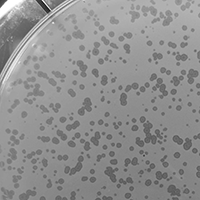Arthrobacter phage Strix
Add or modify phage thumbnail images to appear at the top of this page.
Know something about this phage that we don't? Modify its data.
| Detailed Information for Phage Strix | |
| Discovery Information | |
| Isolation Host | Arthrobacter pascens NRRL B-1814 |
| Found By | Andrew Cameron |
| Year Found | 2025 |
| Location Found | Lexington, GA United States of America |
| Finding Institution | Emory University |
| Program | Science Education Alliance-Phage Hunters Advancing Genomics and Evolutionary Science |
| From enriched soil sample? | No |
| Isolation Temperature | 30°C |
| GPS Coordinates | 33.910022 N, 83.019972 W Map |
| Discovery Notes | Soil was collected from a damp creekbed in the woods near Lexington, GA. Soil was sandy and waterlogged, although the creek had dried up in patches and was not actively flowing at time of collection. Phage was initially isolated on an equal-parts mix of four different Arthrobacter strains (A. globiformis B-2979, A. pascens B-1814, A. globiformis B-4425, A. humicola B-24478). After initial purification, the phage was found to plaque only on A. pascens 1814 A and A. globiformis B-4425. Subsequent stages of purification were done only with A. pascens B-1814. Prior to naming, this phage was designated S2.1 throughout the isolation process. Isolated in the lab of Dr. Nic Vega. |
| Naming Notes | Last night while out for a run on the Atlanta Beltline trail near Chosewood Park, I was attacked from behind by a large Barred Owl (Strix varia). I am not sure if it saw me as a threat or took my head for prey, but thankfully its talons did not find purchase. I am naming this phage for that specific owl, and also because the plaques formed by this phage somewhat resemble the round, ringed eyes of an owl. |
| Sequencing Information | |
| Sequencing Complete? | No |
| Genome length (bp) | Unknown |
| Character of genome ends | Unknown |
| Fasta file available? | No |
| Characterization | |
| Cluster | Unclustered |
| Subcluster | -- |
| Annotating Institution | Unknown or unassigned |
| Annotation Status | Not sequenced |
| Plaque Notes | The most striking visual characteristic of these plaques is their “bullseye” appearance — somewhat clear in the center, surrounded by a turbid ring, and this surrounded by a clear ring. Outer margin well-defined but not sharp. Plaques roughly circular and vary in size, but rarely exceed 2mm in diameter. |
| Has been Phamerated? | No |
| Publication Info | |
| Uploaded to GenBank? | No |
| GenBank Accession | None yet |
| Refseq Number | None yet |
| Archiving Info | |
| Archiving status | Not in Pitt Archives |
| Available Files | |
| Plaque Picture | Download |
